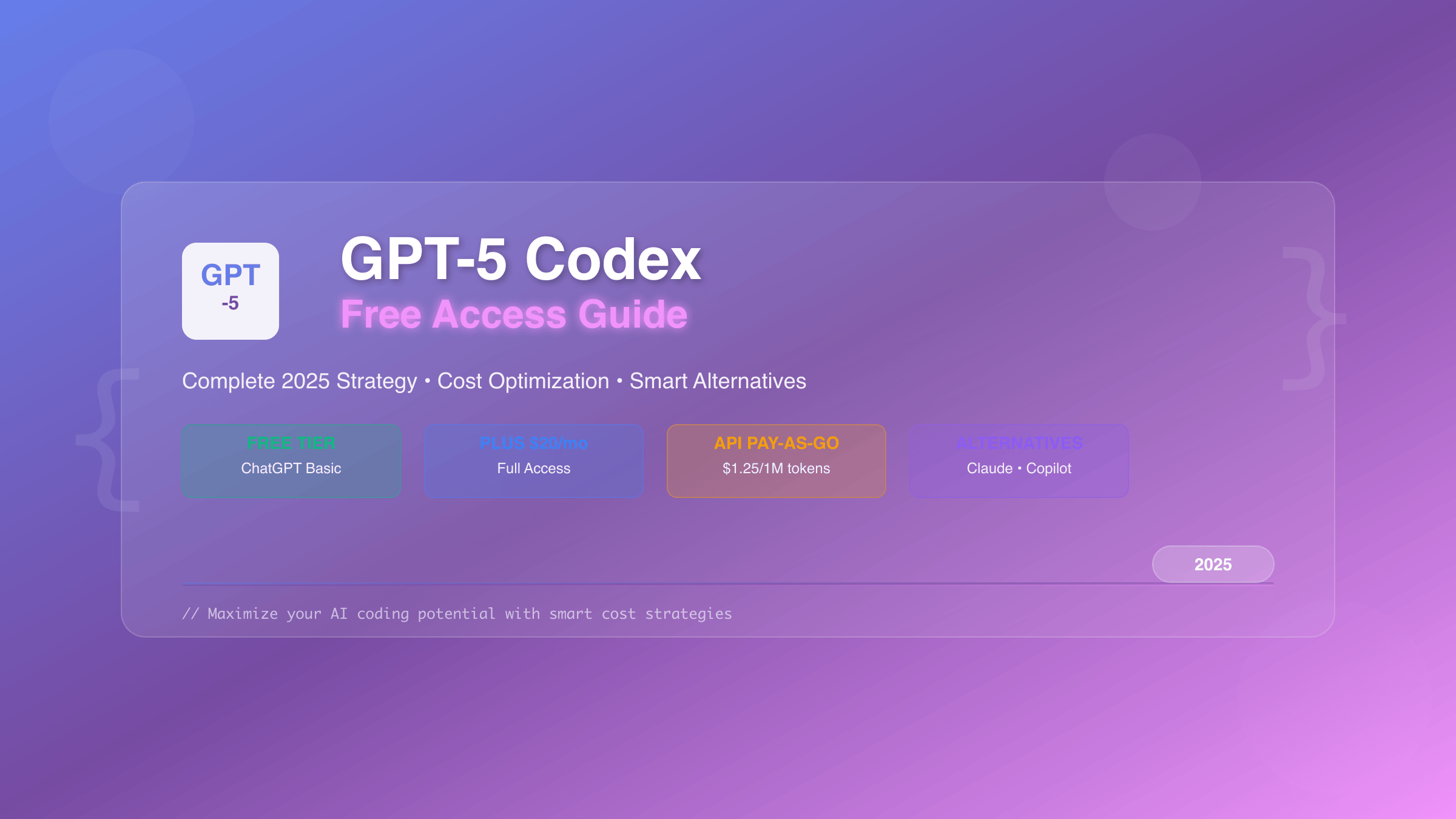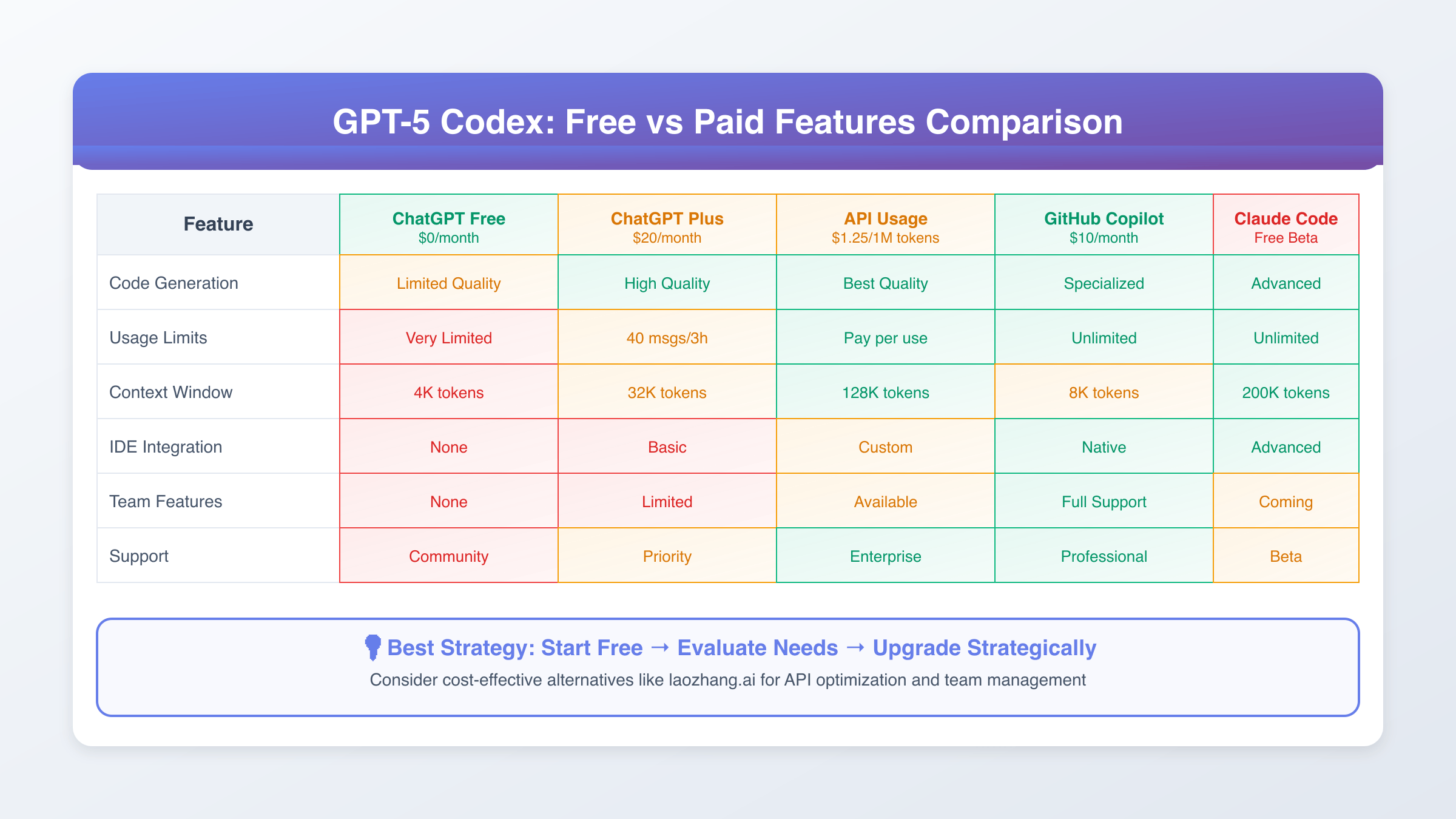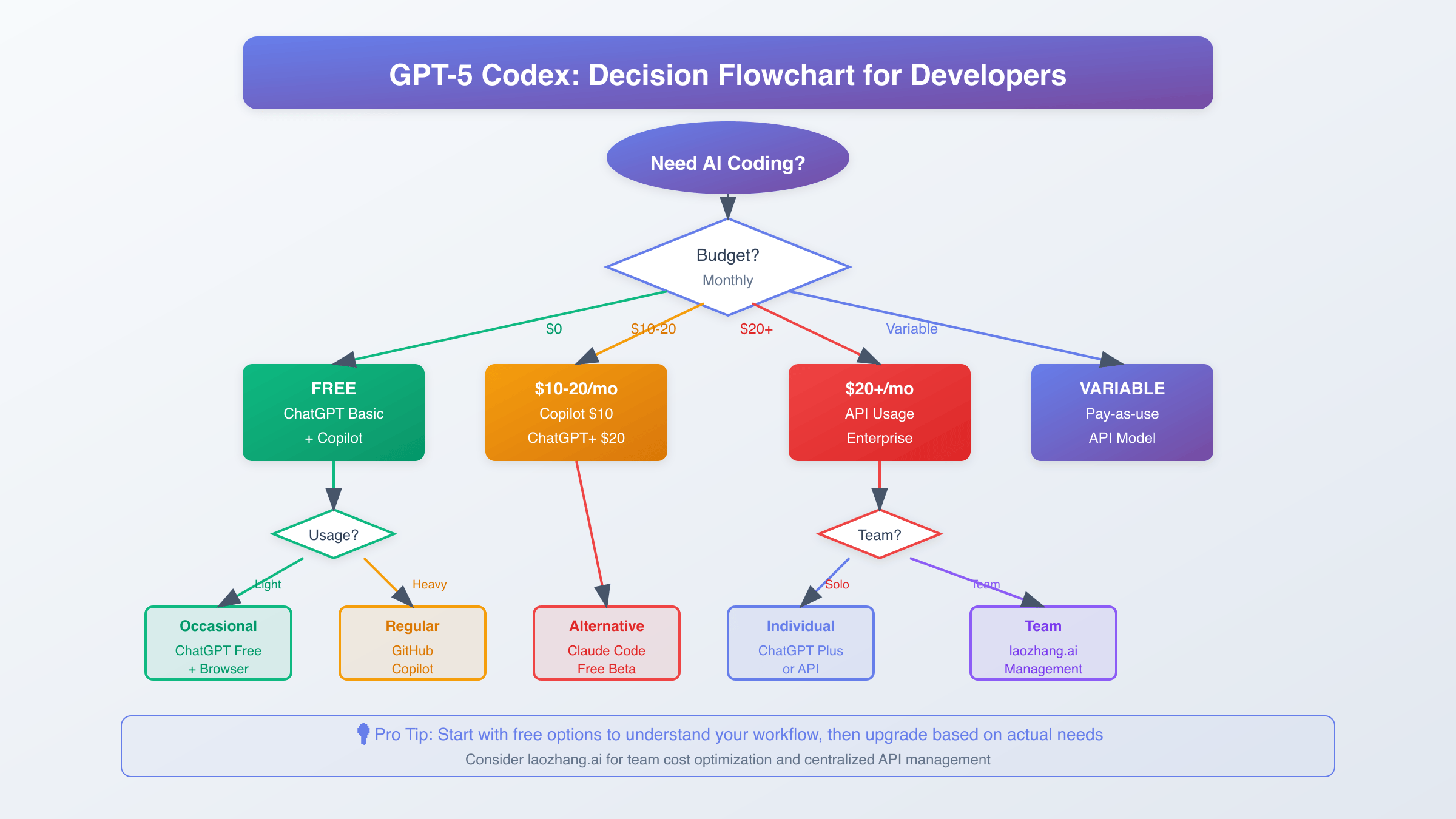GPT-5 Codex doesn’t offer a standalone free tier. Free users can access basic coding features through ChatGPT’s free plan with strict usage limits (30-150 messages per 5 hours). For full functionality, developers need ChatGPT Plus ($20/month) or API access ($1.25 per million tokens). Consider alternatives like Claude Code for budget-conscious development.

As artificial intelligence reshapes software development, developers worldwide are eager to harness GPT-5 Codex’s advanced coding capabilities without breaking their budgets. The reality, however, is more nuanced than many expect. While OpenAI doesn’t provide a completely free version of GPT-5 Codex, several pathways exist for accessing its power at minimal or no cost.
This comprehensive guide examines every available method for accessing GPT-5 Codex features without paying full price, from ChatGPT’s free tier limitations to API optimization strategies. We’ll analyze when free access makes sense, compare alternatives, and provide a data-driven framework for upgrade decisions. Whether you’re an independent developer, startup founder, or enterprise decision-maker, this analysis will help you maximize value while controlling costs.
Understanding GPT-5 Codex Availability and Pricing Structure
GPT-5 Codex represents OpenAI’s latest advancement in AI-powered code generation, building upon the success of previous Codex models with enhanced reasoning capabilities and broader programming language support. Unlike its predecessors, GPT-5 Codex integrates seamlessly with existing development workflows while offering improved accuracy in complex coding scenarios.
The pricing structure reflects OpenAI’s strategic positioning of GPT-5 Codex as a premium development tool. ChatGPT Plus subscribers gain access to GPT-5 Codex capabilities for $20 monthly, while API users pay $1.25 per million tokens for o1-preview model access. For detailed cost analysis and optimization strategies, see our comprehensive GPT-4o pricing guide. These rates position GPT-5 Codex competitively against GitHub Copilot ($10-19/month) and other AI coding assistants.
Free access limitations stem from computational costs associated with the model’s complexity. GPT-5 Codex requires significantly more processing power than standard language models, making completely free access economically challenging for OpenAI. However, the company provides limited free access through ChatGPT’s standard tier, allowing developers to experiment with core functionality.
Maximizing ChatGPT Free Tier for Coding Tasks
ChatGPT’s free tier offers the most accessible entry point to GPT-5 Codex capabilities, albeit with significant restrictions. Free users receive 30-150 messages every five hours, depending on server load and demand patterns. This allocation typically supports 2-4 substantial coding sessions daily, making it suitable for light development work or learning purposes.
The key to maximizing free tier value lies in strategic prompt engineering. Instead of asking multiple small questions, developers should craft comprehensive prompts that request complete code solutions, documentation, and explanations in single interactions. For example, requesting “a complete Python class for user authentication with email validation, password hashing, and session management” yields more value than separate queries for each component.
Free tier limitations become apparent in iterative development scenarios. Complex debugging sessions, extensive code reviews, or multi-file project generation quickly exhaust message quotas. However, for code learning, quick prototyping, or occasional problem-solving, the free tier provides substantial utility without financial commitment.
Timing strategies can extend free tier effectiveness. Usage patterns show lower demand during off-peak hours (typically 2-6 AM PST), when message allocations tend toward the higher 150-message limit. Developers in different time zones can leverage these patterns to maximize available interactions.
API Free Credits and Cost Optimization Strategies
OpenAI provides $5 in free API credits to new accounts, equivalent to approximately 4 million tokens of GPT-5 Codex usage at current pricing. While seemingly modest, these credits support extensive experimentation when used strategically. A typical code generation request consumes 500-2000 tokens, meaning free credits can facilitate 100-200 coding sessions. If you encounter quota issues, our OpenAI quota exceeded error guide provides comprehensive solutions.
Cost optimization begins with understanding token economics. Input tokens (your prompts) and output tokens (generated responses) both count toward usage. Efficient prompting reduces total token consumption while maintaining output quality. Clear, specific prompts generate focused responses, avoiding verbose explanations that inflate token costs.
Batch processing maximizes credit value by grouping related requests. Instead of separate API calls for function creation, testing, and documentation, developers can request comprehensive solutions in single interactions. This approach reduces API overhead while generating more cohesive code solutions.
Token monitoring tools help track usage patterns and identify optimization opportunities. OpenAI’s dashboard provides detailed consumption analytics, while third-party tools like laozhang.ai offer enhanced monitoring capabilities with intelligent routing that can reduce overall API costs by 30-40% through efficient model selection and caching strategies.
GitHub Copilot Integration and Alternative Access
GitHub announced GPT-5 Codex integration into GitHub Copilot during September 2025, expanding access channels for developers already using Microsoft’s ecosystem. Copilot’s $10 monthly individual plan or $19 business plan provides GPT-5 Codex functionality within familiar development environments like VS Code, IntelliJ, and Neovim.
This integration offers advantages over direct ChatGPT access, particularly for developers preferring IDE-native experiences. Copilot’s context awareness leverages entire codebases for more accurate suggestions, while inline completion reduces context switching between browser and editor. However, the monthly subscription cost makes it less attractive for occasional users.
Students and open source contributors can access GitHub Copilot free through GitHub Education benefits. This pathway provides full GPT-5 Codex functionality at no cost for eligible users, representing one of the most comprehensive free access options available. Verification requires active student status or significant open source contributions.
Enterprise GitHub plans include Copilot access, potentially making GPT-5 Codex available to developers whose organizations already invest in GitHub’s premium services. This indirect access model reduces individual cost burden while providing professional-grade AI assistance.
Free Alternative AI Coding Tools Comparison

Several free alternatives provide AI-powered coding assistance without GPT-5 Codex’s premium pricing. Code Llama, Meta’s open-source coding model, offers competitive performance for many programming tasks while running entirely free on suitable hardware. Installation requires 13-34GB storage depending on model size, but provides unlimited usage without API costs or message limits. For a detailed comparison between different coding assistants, check our Codex vs Claude Code comparison guide.
Claude Code presents another alternative with generous free tiers and strong coding capabilities. Anthropic’s offering includes 100,000 tokens monthly at no cost, supporting substantial coding projects while maintaining conversation context across sessions. The interface emphasizes safety and accuracy, though it may generate more conservative code suggestions compared to GPT-5 Codex’s aggressive optimization. Developers can also explore Gemini API’s free tier which offers 5-15 RPM limits for additional coding assistance.
Smaller specialized tools like Tabnine offer freemium models with basic autocomplete functionality. While less sophisticated than GPT-5 Codex for complex reasoning tasks, these tools excel in routine code completion and syntax assistance. Free tiers typically support individual developers with reasonable daily usage allowances.
Performance benchmarks reveal trade-offs between free alternatives and premium solutions. GPT-5 Codex achieves 74.5% success rate on SWE-bench evaluations, while Code Llama reaches approximately 60-65% depending on model size. For many development scenarios, this performance difference doesn’t justify premium pricing, especially when combined with free alternatives’ unlimited usage.
When Free Access Becomes Insufficient: Upgrade Triggers
Free tier limitations manifest differently across development contexts. Individual developers often reach upgrade decisions when daily message limits consistently interrupt workflow, typically occurring after 3-4 weeks of regular use. The frustration of incomplete coding sessions or forced delays during critical problem-solving drives subscription decisions more than feature limitations.
Team environments amplify free tier constraints exponentially. Multiple developers sharing knowledge bases or collaborating on complex projects quickly exhaust individual quotas. Code review processes, architectural discussions, and knowledge transfer activities consume substantial message allocations, making team-wide free usage impractical for professional development.
Project complexity serves as another upgrade trigger. Simple scripts, learning exercises, or prototype development work well within free limitations. However, enterprise applications, multi-service architectures, or performance-critical systems require extensive AI interaction for optimization, debugging, and documentation generation.
Revenue generation provides clear upgrade justification metrics. Developers earning $1000+ monthly from software projects typically recover subscription costs within days through productivity gains. The ability to complete projects 20-30% faster often justifies premium AI tooling as business investments rather than expenses.
Cost-Benefit Analysis Framework for Upgrade Decisions
Quantifying GPT-5 Codex’s value proposition requires systematic analysis of productivity improvements versus subscription costs. Baseline measurements should establish current development speeds, debugging times, and research durations before AI assistance. Most developers experience 15-25% productivity gains after adapting workflows to AI-assisted development patterns.
Hourly rate calculations provide clear upgrade thresholds. Developers billing $50+ hourly need only 24 minutes of saved time monthly to justify ChatGPT Plus subscriptions. Higher-rate consultants ($100-200/hour) recover costs through 6-12 minutes of monthly time savings, making premium AI tools obvious financial decisions.
Hidden costs analysis reveals additional considerations beyond subscription fees. Learning curves for effective AI prompting, workflow adaptation periods, and dependency risks should factor into decision frameworks. Some developers experience 2-3 week adjustment periods before realizing full productivity benefits, requiring patience and systematic skill development.
Alternative cost structures like API usage can provide more granular control for irregular users. Developers with sporadic coding needs might prefer pay-per-use API access over fixed monthly subscriptions. Historical usage patterns help predict whether subscription or per-token pricing offers better value for specific use cases.
Enterprise Implementation and Budget Planning
Enterprise GPT-5 Codex adoption involves complex budget planning beyond individual subscriptions. Team productivity improvements, code quality enhancements, and reduced debugging time create measurable business value, but implementation costs include training, integration, and change management expenses.
Pilot program approaches minimize risk while demonstrating value. Organizations typically start with 5-10 developers across different projects to measure productivity impact, code quality improvements, and team adoption rates. Successful pilots show 20-35% faster development cycles and 15-25% fewer production bugs within 90-day evaluation periods.
Scaling costs follow predictable patterns based on team size and usage intensity. Heavy users (backend developers, DevOps engineers) generate 3-4x more API calls than occasional users (frontend developers, QA engineers). Budget planning should account for this usage distribution rather than assuming uniform consumption across teams.
ROI calculations become compelling at scale. Teams of 20+ developers often recover entire tooling costs within 30-60 days through accelerated delivery timelines. The ability to complete projects 25-40% faster translates directly to revenue recognition acceleration and resource allocation optimization.
For organizations evaluating API integration strategies, services like laozhang.ai provide enterprise-focused solutions with enhanced cost control, usage analytics, and team collaboration features. These platforms often reduce per-token costs while adding management capabilities essential for larger development teams.
Advanced Free Usage Optimization Techniques
Power users develop sophisticated strategies for maximizing free tier value through careful resource management and strategic timing. Session planning involves preparing comprehensive prompt lists before accessing ChatGPT, minimizing wasted interactions through unclear or incomplete requests. This preparation phase can double or triple effective usage from limited message allowances.
Context preservation techniques help maintain conversation continuity across multiple sessions. Saving and reloading conversation summaries, maintaining external documentation of AI-generated insights, and structuring follow-up prompts for context efficiency all contribute to more effective free tier utilization.
Multi-account strategies, while ethically questionable, remain technically possible for users requiring additional free access. However, this approach violates OpenAI’s terms of service and risks account suspension. More sustainable approaches include collaborating with team members to distribute usage across legitimate accounts.
Prompt engineering optimization reduces token consumption while improving response quality. Specific, technical language generates focused responses, while vague requests produce verbose explanations that exhaust quotas quickly. Successful free tier users develop prompting skills that maximize information density per interaction.
Integration with Development Workflows and Toolchains
Effective GPT-5 Codex integration requires thoughtful workflow adaptation rather than simple tool addition. Developers achieve best results by identifying specific use cases where AI assistance provides maximum value: boilerplate generation, API integration code, test case creation, and documentation writing represent high-impact applications.
IDE integration approaches vary based on available budget and technical requirements. Premium options like GitHub Copilot offer seamless editor integration, while budget-conscious developers can achieve similar results through browser-based interactions combined with efficient copy-paste workflows. The key lies in minimizing context switching overhead.
Version control integration helps track AI-generated code contributions while maintaining code review standards. Many teams develop policies for AI-assisted development, including required human review for generated code, documentation of AI usage, and testing standards for machine-generated solutions.
Testing strategies become crucial when incorporating AI-generated code into production systems. Comprehensive test suites, code review processes, and gradual integration approaches help maintain code quality while leveraging AI productivity benefits. Free tier users should prioritize testing infrastructure to maximize confidence in limited AI interactions.
Performance Benchmarking and Quality Assessment
Understanding GPT-5 Codex’s strengths and limitations guides effective usage within free tier constraints. The model excels at standard algorithms, common framework usage, and well-documented programming patterns. Performance drops notably for domain-specific code, uncommon libraries, or highly optimized performance requirements.
Accuracy assessments reveal language-specific variations in GPT-5 Codex performance. Python and JavaScript generation typically achieves 85-90% accuracy for common tasks, while specialized languages like Rust or Go may see 70-80% accuracy rates. Understanding these patterns helps prioritize free usage for highest-value scenarios.
Code quality metrics provide objective measures for AI-generated solutions. Cyclomatic complexity, maintainability indices, and security vulnerability scans help assess whether AI assistance improves overall code quality or introduces technical debt. Most studies show neutral to positive impacts when combined with proper review processes.
Debugging efficiency represents a critical performance indicator for AI coding tools. GPT-5 Codex demonstrates strong capabilities in error analysis and solution suggestion, often identifying issues human developers miss. This debugging assistance frequently provides disproportionate value relative to other AI features.
Future Development and Access Evolution

OpenAI’s pricing strategy evolution suggests increasing accessibility over time as computational costs decrease and market competition intensifies. Historical patterns show initial premium positioning followed by gradual democratization as models mature and infrastructure scales improve.
Competitive pressure from Google’s Codey, Anthropic’s Claude Code, and open-source alternatives will likely drive more generous free tier offerings. Market dynamics favor increased accessibility as AI coding becomes standard rather than premium capability, suggesting improved free access within 12-18 months. For developers seeking immediate alternatives, our free GPT-4.1 access guide provides additional options for AI-powered development.
Integration partnerships with major platforms (Microsoft, GitHub, Google Cloud) may provide additional free access channels for developers already committed to specific ecosystems. These partnerships often subsidize AI tool costs through broader platform revenue, potentially expanding free usage opportunities.
Open-source model improvements continue reducing barriers to high-quality AI coding assistance. Code Llama, StarCoder, and similar projects approach GPT-5 Codex performance while maintaining complete cost control. This trend suggests free alternatives will become increasingly viable for most development scenarios.
Making the Right Choice: Decision Framework
Choosing between free and paid GPT-5 Codex access depends on systematic evaluation of usage patterns, productivity requirements, and budget constraints. Individual developers should assess current coding velocity, identify specific pain points AI could address, and calculate realistic value propositions based on billing rates or career advancement goals.
Team decisions require broader analysis including collaboration needs, code quality standards, and project delivery timelines. Organizations with aggressive development schedules often find premium AI tooling essential for maintaining competitive delivery speeds, while research teams or educational institutions may achieve adequate results through free alternatives.
Budget allocation strategies should consider AI tools as productivity investments rather than operational expenses. Developers who struggle with specific technical challenges, work with unfamiliar technologies, or manage multiple concurrent projects typically see higher returns from AI assistance investments.
The decision ultimately balances immediate cost savings against long-term productivity improvements. Free access works well for learning, experimentation, and occasional assistance. Professional development work requiring consistent AI support generally justifies premium tooling costs through measurable productivity gains and improved code quality outcomes.
For developers seeking cost-effective API solutions that provide professional-grade capabilities without premium pricing, platforms like laozhang.ai offer intelligent model routing and optimization features that can significantly reduce overall AI coding costs while maintaining access to advanced capabilities. These services bridge the gap between free limitations and premium pricing through efficient resource utilization. Additionally, explore our guides on free Nano Banana access and other emerging AI development tools.
Conclusion: Optimizing Your GPT-5 Codex Strategy
GPT-5 Codex represents a significant advancement in AI-powered development tools, but free access comes with meaningful limitations that affect real-world usage patterns. Understanding these constraints while implementing strategic optimization techniques helps developers maximize value regardless of budget constraints.
The key to success lies in matching tool capabilities to specific use cases while developing efficient workflows that minimize resource waste. Whether using ChatGPT’s free tier, API credits, or alternative solutions, systematic approaches yield better results than ad-hoc usage patterns.
As the AI coding landscape continues evolving, developers who invest time in understanding these tools’ capabilities and limitations will maintain competitive advantages regardless of which specific platforms they choose. The future belongs to developers who leverage AI assistance effectively, not those who simply adopt the latest tools without strategic implementation.